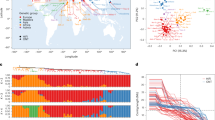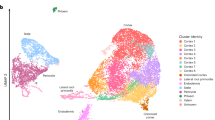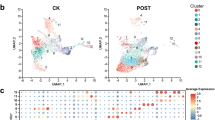Abstract
Plants maximize their fitness by adjusting their growth and development in response to signals such as light and temperature. The circadian clock provides a mechanism for plants to anticipate events such as sunrise and adjust their transcriptional programmes. However, the underlying mechanisms by which plants coordinate environmental signals with endogenous pathways are not fully understood. Using RNA-sequencing and chromatin immunoprecipitation sequencing experiments, we show that the evening complex (EC) of the circadian clock plays a major role in directly coordinating the expression of hundreds of key regulators of photosynthesis, the circadian clock, phytohormone signalling, growth and response to the environment. We find that the ability of the EC to bind targets genome-wide depends on temperature. In addition, co-occurrence of phytochrome B (phyB) at multiple sites where the EC is bound provides a mechanism for integrating environmental information. Hence, our results show that the EC plays a central role in coordinating endogenous and environmental signals in Arabidopsis.
This is a preview of subscription content, access via your institution
Access options
Access Nature and 54 other Nature Portfolio journals
Get Nature+, our best-value online-access subscription
$29.99 / 30 days
cancel any time
Subscribe to this journal
Receive 12 digital issues and online access to articles
$119.00 per year
only $9.92 per issue
Buy this article
- Purchase on Springer Link
- Instant access to full article PDF
Prices may be subject to local taxes which are calculated during checkout






Similar content being viewed by others
References
Willis, C. G., Ruhfel, B., Primack, R. B., Miller-Rushing, A. J. & Davis, C. C. Phylogenetic patterns of species loss in Thoreau's woods are driven by climate change. Proc. Natl Acad. Sci. USA 105, 17029–17033 (2008).
Fitter, A. H. & Fitter, R. S. Rapid changes in flowering time in British plants. Science 296, 1689–1691 (2002).
Dodd, A. N. et al. Plant circadian clocks increase photosynthesis, growth, survival, and competitive advantage. Science 309, 630–633 (2005).
Harmer, S. L. et al. Orchestrated transcription of key pathways in Arabidopsis by the circadian clock. Science 290, 2110–2113 (2000).
Huang, H. & Nusinow, D. A. Into the evening: complex interactions in the Arabidopsis circadian clock. Trends Genet. https://dx.doi.org/10.1016/j.tig.2016.08.002 (2016).
Greenham, K. & McClung, C. R. Integrating circadian dynamics with physiological processes in plants. Nat. Rev. Genet. 16, 598–610 (2015).
Nusinow, D. A. et al. The ELF4-ELF3-LUX complex links the circadian clock to diurnal control of hypocotyl growth. Nature 475, 398–402 (2011).
Thines, B. & Harmon, F. G. Ambient temperature response establishes ELF3 as a required component of the core Arabidopsis circadian clock. Proc. Natl Acad. Sci. USA 107, 3257–3262 (2010).
Filo, J. et al. Gibberellin driven growth in elf3 mutants requires PIF4 and PIF5. Plant Signal. Behav. 10, e992707 (2015).
Koini, M. A. et al. High temperature-mediated adaptations in plant architecture require the bHLH transcription factor PIF4. Curr. Biol. 19, 408–413 (2009).
Kumar, S. V. et al. Transcription factor PIF4 controls the thermosensory activation of flowering. Nature 484, 242–245 (2012).
Thines, B. C., Youn, Y., Duarte, M. I. & Harmon, F. G. The time of day effects of warm temperature on flowering time involve PIF4 and PIF5. J. Exp. Bot. 65, 1141–1151 (2014).
Fernández, V., Takahashi, Y., Le Gourrierec, J. & Coupland, G. Photoperiodic and thermosensory pathways interact through CONSTANS to promote flowering at high temperature under short days. Plant J. 86, 426–440 (2016).
Sureshkumar, S., Dent, C., Seleznev, A., Tasset, C. & Balasubramanian, S. Nonsense-mediated mRNA decay modulates FLM-dependent thermosensory flowering response in Arabidopsis. Nat. Plants 2, 16055 (2016).
Box, M. S. et al. ELF3 controls thermoresponsive growth in Arabidopsis. Curr. Biol. 25, 194–199 (2015).
Raschke, A. et al. Natural variants of ELF3 affect thermomorphogenesis by transcriptionally modulating PIF4-dependent auxin response genes. BMC Plant Biol. 15, 197 (2015).
Helfer, A. et al. LUX ARRHYTHMO encodes a nighttime repressor of circadian gene expression in the Arabidopsis core clock. Curr. Biol. 21, 126–133 (2011).
Chow, B. Y., Helfer, A., Nusinow, D. A. & Kay, S. A. ELF3 recruitment to the PRR9 promoter requires other evening complex members in the Arabidopsis circadian clock. Plant Signal. Behav. 7, 170–173 (2012).
Yu, C.-P., Lin, J.-J. & Li, W.-H. Positional distribution of transcription factor binding sites in Arabidopsis thaliana. Sci. Rep. 6, 25164 (2016).
O'Malley, R. C. et al. Cistrome and epicistrome features shape the regulatory DNA landscape. Cell 165, 1280–1292 (2016).
Mizuno, T. et al. Ambient temperature signal feeds into the circadian clock transcriptional circuitry through the EC night-Time repressor in Arabidopsis thaliana. Plant Cell Physiol. 55, 958–976 (2014).
Hsu, P. Y. & Harmer, S. L. Wheels within wheels: the plant circadian system. Trends Plant Sci. 19, 240–249 (2014).
Mochizuki, N., Brusslan, J. A., Larkin, R., Nagatani, A. & Chory, J. Arabidopsis genomes uncoupled 5 (GUN5) mutant reveals the involvement of Mg-chelatase H subunit in plastid-to-nucleus signal transduction. Proc. Natl Acad. Sci. USA 98, 2053–2058 (2001).
Cheng, N.-H., Liu, J.-Z., Brock, A., Nelson, R. S. & Hirschi, K. D. AtGRXcp, an Arabidopsis chloroplastic glutaredoxin, is critical for protection against protein oxidative damage. J. Biol. Chem. 281, 26280–8 (2006).
Chow, B. Y. et al. Transcriptional regulation of LUX by CBF1 mediates cold input to the circadian clock in Arabidopsis. Curr. Biol. 24,, (2014).
Bai, M.-Y., Fan, M., Oh, E. & Wang, Z.-Y. A triple helix-loop-helix/basic helix-loop-helix cascade controls cell elongation downstream of multiple hormonal and environmental signaling pathways in Arabidopsis. Plant Cell 24, 4917–4929 (2012).
Ikeda, M., Fujiwara, S., Mitsuda, N. & Ohme-Takagi, M. A triantagonistic basic helix-loop-helix system regulates cell elongation in Arabidopsis. Plant Cell 24, 4483–4497 (2012).
Rawat, R. et al. REVEILLE1, a Myb-like transcription factor, integrates the circadian clock and auxin pathways. Proc. Natl Acad. Sci. USA 106, 16883–8 (2009).
Nitschke, S. et al. Circadian stress regimes affect the circadian clock and cause jasmonic acid-dependent cell death in cytokinin-deficient Arabidopsis plants. Plant Cell 28, 1616–1639 (2016).
Huang, H. et al. Identification of evening complex associated proteins in Arabidopsis by affinity purification and mass spectrometry. Mol. Cell. Proteomics 15, 201–217 (2016).
Jung, J.-H. et al. Phytochromes function as thermosensors in Arabidopsis. Science 354, 886–889 (2016).
Legris, M. et al. Phytochrome B integrates light and temperature signals in Arabidopsis. Science 354 897–900 (2016).
Reed, J. W. et al. Independent action of ELF3 and phyB to control hypocotyl elongation and flowering time. Plant Physiol. 122, 1149–1160 (2000).
Dai, S. et al. BROTHER OF LUX ARRHYTHMO is a component of the Arabidopsis circadian clock. Plant Cell 23, 961–972 (2011).
Kaiserli, E. et al. Integration of light and photoperiodic signaling in transcriptional nuclear foci. Dev. Cell 35, 311–321 (2015).
Bendix, C., Marshall, C. M. & Harmon, F. G. Circadian clock genes universally control key agricultural traits. Mol. Plant 8, 1135–1152 (2015).
Battisti, D. S. & Naylor, R. L. Historical warnings of future food insecurity with unprecedented seasonal heat. Science 323, 240–244 (2009).
Strasser, B., Sanchez-Lamas, M., Yanovsky, M. J., Casal, J. J. & Cerdan, P. D. Arabidopsis thaliana life without phytochromes. Proc. Natl Acad. Sci. USA 107, 4776–4781 (2010).
Medzihradszky, M. et al. Phosphorylation of phytochrome B inhibits light-induced signaling via accelerated dark reversion in Arabidopsis. Plant Cell 25, 535–544 (2013).
Jaeger, K. E., Pullen, N., Lamzin, S., Morris, R. J. & Wigge, P. A. Interlocking feedback loops govern the dynamic behavior of the floral transition in Arabidopsis. Plant Cell 25, 820–833 (2013).
Langmead, B. & Salzberg, S. L. Fast gapped-read alignment with bowtie 2. Nat. Methods 9, 357–359 (2012).
Li, H. et al. The sequence alignment/Map format and SAMtools. Bioinformatics 25, 2078–2079 (2009).
Zhang, Y. et al. Model-based analysis of ChIP-Seq (MACS). Genome Biol. 9, R137 (2008).
Quinlan, A. R. & Hall, I. M. BEDTools: a flexible suite of utilities for comparing genomic features. Bioinformatics 26, 841–842 (2010).
Heinz, S. et al. Simple combinations of lineage-determining transcription factors prime cis-regulatory elements required for macrophage and B cell identities. Mol. Cell 38, 576–589 (2010).
Bolger, A. M., Lohse, M. & Usadel, B. Trimmomatic: a flexible trimmer for illumina sequence data. Bioinformatics 30, 2114–2120 (2014).
Trapnell, C., Pachter, L. & Salzberg, S. L. Tophat: discovering splice junctions with RNA-seq. Bioinformatics 25, 1105–1111 (2009).
Anders, S., Pyl, P. T. & Huber, W. HTSeq--a python framework to work with high-throughput sequencing data. Bioinformatics 31, 166–169 (2015).
Robinson, M. D., McCarthy, D. J. & Smyth, G. K. Edger: a bioconductor package for differential expression analysis of digital gene expression data. Bioinformatics 26, 139–140 (2010).
Mi, H., Muruganujan, A., Casagrande, J. T. & Thomas, P. D. Large-scale gene function analysis with the PANTHER classification system. Nat. Protoc. 8, 1551–1566 (2013).
Tang, H. et al. GAOTOOLS: Tools for Gene Ontology. Zenodo. http://dx.doi.org/10.5281/zenodo.31628 (2015).
Jansson . A guide to the Lhc genes and their relatives in Arabidopsis. Trends Plant Sci. 4, 236–240 (1999).
Hornitschek, P. et al. Phytochrome interacting factors 4 and 5 control seedling growth in changing light conditions by directly controlling auxin signaling. Plant J. 71, 699–711 (2012).
Mitra, A., Choi, H. K. & An, G. Structural and functional analyses of Arabidopsis thaliana chlorophyll a/b-binding protein (cab) promoters. Plant Mol. Biol. 12, 169–179 (1989).
Beligni, M. V. & Mayfield, S. P. Arabidopsis thaliana mutants reveal a role for CSP41a and CSP41b, two ribosome-associated endonucleases, in chloroplast ribosomal RNA metabolism. Plant Mol. Biol. 67, 389–401 (2008).
Park, D. H. et al. Control of circadian rhythms and photoperiodic flowering by the Arabidopsis GIGANTEA gene. Science 285, 1579–82 (1999).
Salome, P. A. & McClung, C. R. PSEUDO-RESPONSE REGULATOR 7 and 9 are partially redundant genes essential for the temperature responsiveness of the Arabidopsis circadian clock. Plant Cell 17, 791–803 (2005).
Salome, P. A., Weigel, D. & McClung, C. R. The role of the Arabidopsis morning loop components CCA1, LHY, PRR7, and PRR9 in temperature compensation. PLANT CELL ONLINE 22, 3650–3661 (2010).
Seung, D. et al. Arabidopsis thaliana AMY3 is a unique redox-regulated chloroplastic α-amylase. J. Biol. Chem. 288, 33620–33 (2013).
Seaton, D. D. et al. Linked circadian outputs control elongation growth and flowering in response to photoperiod and temperature. Mol. Syst. Biol. 11, 776 (2015).
Jaglo-Ottosen, K. R., Gilmour, S. J., Zarka, D. G., Schabenberger, O. & Thomashow, M. F. Arabidopsis CBF1 overexpression induces COR genes and enhances freezing tolerance. Science 280, 104–106 (1998).
Riechmann, J. L. et al. Arabidopsis transcription factors: genome-wide comparative analysis among eukaryotes. Science 290, 2105–2110 (2000).
Chen, K.-M. et al. Small chloroplast-targeted DnaJ proteins are involved in optimization of photosynthetic reactions in Arabidopsis thaliana. BMC Plant Biol. 10, 43 (2010).
Kendall, S. L. et al. Induction of dormancy in Arabidopsis summer annuals requires parallel regulation of DOG1 and hormone metabolism by low temperature and CBF transcription factors. Plant Cell 23, 2568–80 (2011).
Wang, H. et al. Regulation of Arabidopsis brassinosteroid signaling by atypical basic helix-loop-helix proteins. Plant Cell 21, 3781–3791 (2009).
Crocco, C. D. et al. The transcriptional regulator BBX24 impairs DELLA activity to promote shade avoidance in Arabidopsis thaliana. Nat. Commun. 6, 6202 (2015).
Gangappa, S. N. et al. The Arabidopsis B-BOX protein BBX25 interacts with HY5, negatively Regulating BBX22 expression to suppress seedling photomorphogenesis. Plant Cell 25, 1243–1257 (2013).
Bartrina, I., Otto, E., Strnad, M., Werner, T. & Schmülling, T. Cytokinin regulates the activity of reproductive meristems, flower organ size, ovule formation, and thus seed yield in Arabidopsis thaliana. Plant Cell 23, 69–80 (2011).
Zwack, P. J. & Rashotte, A. M. Interactions between cytokinin signalling and abiotic stress responses. J. Exp. Bot. 66, 4863–4871 (2015).
Cutcliffe, J. W., Hellmann, E., Heyl, A. & Rashotte, A. M. CRFs form protein–protein interactions with each other and with members of the cytokinin signalling pathway in Arabidopsis via the CRF domain. J. Exp. Bot. 62, 4995–5002 (2011).
Zwack, P. J. et al. Cytokinin response factor 6 represses cytokinin-associated genes during oxidative stress. Plant Physiol. 172, pp. 00415.2016 (2016).
Wilson, M. E., Mixdorf, M., Berg, R. H. & Haswell, E. S. Plastid osmotic stress influences cell differentiation at the plant shoot apex. Development 143, 3382–93 (2016).
Rawat, R. et al. REVEILLE1, a Myb-like transcription factor, integrates the circadian clock and auxin pathways. Proc. Natl Acad. Sci. USA 106, 16883–8 (2009).
Dong, T. et al. Abscisic Acid uridine diphosphate glucosyltransferases play a crucial role in abscisic acid homeostasis in Arabidopsis. Plant Physiol. 165, 277–289 (2014).
Rizza, A., Boccaccini, A., Lopez-Vidriero, I., Costantino, P. & Vittorioso, P. Inactivation of the ELIP1 and ELIP2 genes affects Arabidopsis seed germination. New Phytol. 190, 896–905 (2011).
Li, G. et al. Coordinated transcriptional regulation underlying the circadian clock in Arabidopsis. Nat. Cell Biol. 13, 616–622 (2011).
Acknowledgements
We thank members of the Wigge laboratory for feedback and discussions. This work was supported by the Biotechnology and Biology Research Council (RG80054 to P.A.W.); P.A.W.'s laboratory is supported by a Fellowship from the Gatsby Foundation (GAT3273/GLB). Funding for open access charge: (Gatsby Foundation/GAT3273/GLB). We thank S. Kay for providing us with the gLUX-GFP lux-4 and gELF4-HA elf4-2 transgenic plants.
Author information
Authors and Affiliations
Contributions
D.E.: wrote a large proportion of the manuscript, lead researcher on all analysis. Involved in experimental design, prepared Figs 1–4. J.-H.J.: experimental design, generated Fig. 5, created lines used in the study. H.L.: extensive bioinformatics analysis. Mapped and analysed most of the datasets for the ChIP experiments. Performed motif searching and so on. S.B.: performed the initial mapping of the first ELF3 ChIP and made insights into rhythmical gene expression using clustering that were instrumental in the development of the project. L.G.: collaborating group. Performed the first analysis of EC binding and motif analysis. M.S.B.: generated the RNA-seq time course datasets. V.C.: generated the RNA-seq time course datasets. S.C.: generated the RNA-seq time course datasets. D.S.: helped perform ChIP-seq experiments. C.Z.: PI. Collaborator, supervisor of L.G., made key structural biology and experimental design contributions. Helped write the paper. K.E.J.: PI. Performed all the ChIP-seq experiments the paper is based on. Writing the paper and experimental design. P.A.W.: PI. Experimental design and discussions, helped write the paper.
Corresponding author
Ethics declarations
Competing interests
The authors declare no competing financial interests.
Supplementary information
Supplementary Information
Supplementary Figures 1–7. (PDF 43186 kb)
Supplementary Table 1
A table containing information about the sequencing quality, such as the number of reads and the number of mapped reads, for each ChIP-seq experiment. (XLSX 38 kb)
Supplementary Table 2
A table containing ChIP-seq peaks predicted by MACS2 for ELF3, ELF4, and LUX at 22 °C and LUX at 17 °C. (XLSX 180 kb)
Supplementary Table 3
A table containing the details of all the statistical analysis (that is, the contingency tables used in the Fisher exact tests). (XLSX 22 kb)
Supplementary Table 4
A table containing information about both the de novo predicted motifs from HOMER2 and the occurrence of the G-box, LBS, and 'motif 2' motifs in the peaks that are within 3000 bp of differentially expressed genes. (XLSX 197 kb)
Supplementary Table 5
A table containing TPM values for the Col-0, elf3-1 and lux-4 time courses at 22 °C and 27 °C. (XLSX 33808 kb)
Supplementary Table 6
A table containing the list of genes that are within the top 5% most differentially expressed in elf3-1 versus Col-0 or lux-4 versus Col-0 in at least one time point. (XLSX 178 kb)
Supplementary Table 7
A table containing lists the GO annotations of each of the predicted target genes from Supplementary Table 4. (XLSX 84 kb)
Supplementary Table 8
A table containing the raw data used in the production of Fig. 5a. (XLSX 40 kb)
Rights and permissions
About this article
Cite this article
Ezer, D., Jung, JH., Lan, H. et al. The evening complex coordinates environmental and endogenous signals in Arabidopsis. Nature Plants 3, 17087 (2017). https://doi.org/10.1038/nplants.2017.87
Received:
Accepted:
Published:
DOI: https://doi.org/10.1038/nplants.2017.87
This article is cited by
-
Limited water stress modulates expression of circadian clock genes in Brachypodium distachyon roots
Scientific Reports (2023)
-
A mis-splicing early flowering 3 (elf3) allele of lentil is associated with yield enhancement under terminal heat stress
Journal of Applied Genetics (2023)
-
Transcriptional Feedback in Plant Growth and Defense by PIFs, BZR1, HY5, and MYC Transcription Factors
Plant Molecular Biology Reporter (2022)
-
EARLY FLOWERING 3 represses the nighttime growth response to sucrose in Arabidopsis
Photochemical & Photobiological Sciences (2022)
-
Effects of varying temperature on rhythmic expression of abiotic stress-responding genes in Tibetan hulless barley
Acta Physiologiae Plantarum (2022)



